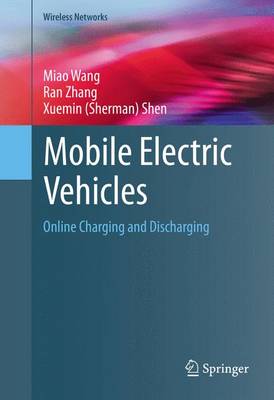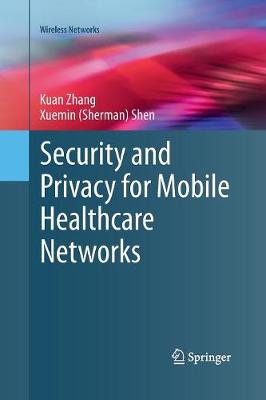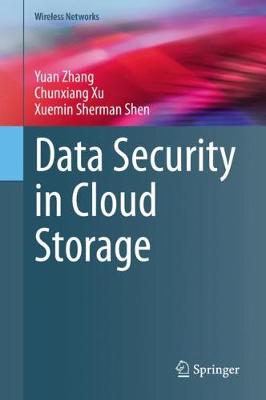Wireless Networks
5 total works
Mobile Electric Vehicles
by Miao Wang, Ran Zhang, and Xuemin (Sherman) Shen
This book examines recent research on designing online charging and discharging strategies for mobile electric vehicles (EVs) in smart grid. First, the architecture and applications are provided. Then, the authors review the existing works on charging and discharging strategy design for EVs. Critical challenges and research problems are identified. Promising solutions are proposed to accommodate the issues of high EV mobility, vehicle range anxiety, and power systems overload.
The authors investigate innovating charging and discharging potentials for mobile EVS based on real-time information collections (via VANETS and/or cellular networks) and offer the power system adjustable load management methods. Several innovative charging/discharging strategy designs to address the challenging issues in smart grid, i.e., overload avoidance and range anxiety for individual EVs, are presented. This book presents an alternative and promising way to release the pressure of the power grid caused by peak-time EV charging demand.
Mobile Electric Vehicles: Online Charging and Discharging provides valuable insights on charging/ discharging strategy design for mobile EVs and the power system management in a smart grid. The authors’ findings indicate that the proposed strategies considerably outperform the traditional EV charging strategies without real-time collections on the metrics of the overall energy utilizat
ion, the average EV travel cost and the number of successfully charged EVs. Research and graduate students who are working on smart grid and vehicular communication will find this book a valuable resource. Customs and systems operators will also find this book useful.
Security and Privacy for Mobile Healthcare Networks
by Kuan Zhang and Xuemin (Sherman) Shen
This book examines state-of-art research on designing healthcare applications with the consideration of security and privacy. It explains the Mobile Healthcare Network (MHN) architecture and its diverse applications, and reviews the existing works on security and privacy for MHNs. Critical future challenges and research problems are also identified.
Using a Quality-of-Protection perspective, the authors provide valuable insights on security and privacy preservation for MHNs. Some promising solutions are proposed to accommodate the issues of secure health data transmission, misbehavior detection, health data processing with privacy preservation and access control in MHNs. Specifically, the secure health data aggregation explores social spots to help forward health data and enable users to select the optimal relay according to their social ties and health data priority. The secure aggregation achieves the desirable delivery ratio with reasonable communication costs and lower delay for the data in different priorities.
A proposed misbehavior detection scheme distinguishes Sybil attackers from normal users by comparing their mobile contacts and pseudonym changing behaviors. The detection accuracy is high enough to resist various Sybil attacks including forgery. In addition, the health data processing scheme can analyze the encrypted health data and preserve user's privacy at the same time. Attribute based access control can achieve fine-grained acces
s control with user-defined access policy in MHNs.Security and Privacy for Mobile Healthcare Networks is designed for researchers and advanced-level students interested in healthcare security and secure data transmission.
Data Security in Cloud Storage
by Yuan Zhang, Chunxiang Xu, and Xuemin (Sherman) Shen
This book provides a comprehensive overview of data security in cloud storage, ranging from basic paradigms and principles, to typical security issues and practical security solutions. It also illustrates how malicious attackers benefit from the compromised security of outsourced data in cloud storage and how attacks work in real situations, together with the countermeasures used to ensure the security of outsourced data. Furthermore, the book introduces a number of emerging technologies that hold considerable potential – for example, blockchain, trusted execution environment, and indistinguishability obfuscation – and outlines open issues and future research directions in cloud storage security.
The topics addressed are important for the academic community, but are also crucial for industry, since cloud storage has become a fundamental component in many applications. The book offers a general introduction for interested readers with a basic modern cryptography background, and a reference guide for researchers and practitioners in the fields of data security and cloud storage. It will also help developers and engineers understand why some current systems are insecure and inefficient, and move them to design and develop improved systems.
Intelligent Resource Management in Vehicular Networks
by Haixia Peng, Qiang Ye, and Xuemin (Sherman) Shen
This book provides a comprehensive investigation on new technologies for future vehicular networks. The authors propose different schemes to efficiently manage the multi-dimensional resources for supporting diversified applications. The authors answer the questions of why connected and automated vehicle technology should be considered; how the multi-access edge computing (MEC) and unmanned aerial vehicle (UAV) technologies can be helpful to vehicular networks; how to efficiently manage the multi-dimensional resources to support different vehicular applications with guaranteed quality-of-service (QoS) requirements; and how to adopt optimization and AI technologies to achieve resource management in vehicular networks. The book is pertinent to researchers, professionals, academics and students in vehicular technologies.
Secure Automatic Dependent Surveillance-Broadcast Systems (ADS-B)
by Haomiao Yang, Hongwei Li, and Xuemin (Sherman) Shen
This book proposes secure schemes to address security challenges in secure automatic dependent surveillance-broadcast systems (ADS-B) from five different angles. First, the authors examine encryption schemes applied to the ADS-B environment for protecting messages confidentiality. Second, they propose an ADS-B broadcast authentication scheme with batch verification by employing an identity-based signature. Third, they present ADS-B broadcast authentication scheme based on a digital signature with message recovery, which provides a feature that the message is recoverable from the signature. Fourth, they propose a new cryptographic solution to ADS-B security. Finally, they propose an accurate and efficient cognitive aircraft location verification scheme preserving aircraft location privacy by utilizing a grid-based k-nearest neighbor algorithm. In summary, the authors show how ADS-B data links can greatly enhance flight safety by these proposed schemes without sacrificing data security.
Proposes several secure schemes to address security challenges in secure automatic dependent surveillance-broadcast systems (ADS-B);
Provides extensive experiments and evaluates the proposed schemes using real-world data;
Shows how ADS-B data links can greatly enhance safety without sacrificing data security




